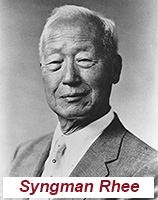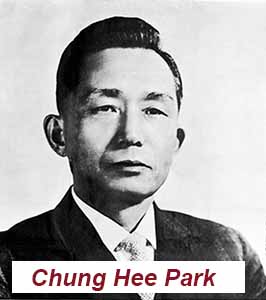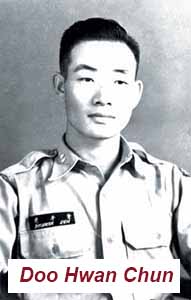Learn

1st ROK (Republic of Korea)
Watch Liberation! (:14)

1948 - Establishment of the Republic of Korea
After liberation from Japan and foreign assistance, Korea had a temporary government without a constitution. The first election was held, and the first President was elected by representatives, a system similar to the Electoral College SystemPeople representing states who cast votes for the election of the President and Vice President. in the United States. South Korea's first President was Syngman Rhee. President Rhee established the first constitution, South Korean government, and inaugurated the 1st Republic of Korea.
Likewise, North Korea also elected their first president, Il-sung Kim, and established the Democratic People's Republic of Korea (which ironically is not democratic, but communist).
Constitutional Changes
Watch Constitutional Changes (:42).
July 1952 - During the Korean War, President Rhee revised the constitution so he could be re-elected. Because the majority of Electoral College members were hostile toward him, he campaigned to change the election method to direct citizen involvement. As he appealed to the South Korean people for direct elections and protection from North Korea, Rhee won re-election.
November 1954 - Similar to the U.S. Constitution, the South Korean constitution limited the President to two terms. President Rhee had already been elected twice; however, he did not want to give up power when his term was up in two years. Fraudulent tactics were used to amend the constitution in order to get rid of the two-term limit. Without enough votes to pass the amendment, Rhee forced it through by "Rounding Off" the numbers, and that is what the amendment came to be called.
March 1960 - Again, President Rhee wanted to extend his time in office. The government was severely corrupt and for that reason the election was corrupted as well. The regime used different polling places and hours than what the citizens had been told. Some voting locations were guarded by the military to keep citizens from voting. Moreover, Rhee supporters stuffed the ballot box with millions of fake ballots to ensure President Rhee would win re-election.
If you would like, you can read more about Syngman Rhee at Encyclopaedia Britannica.

2nd ROK (Republic of Korea)
Watch Revolution (:45)
April 19, 1960 - President Rhee won the election but the citizens of South Korea became angry because of the level of corruption and protested his regime. His military suppressed protesters with tear gas and weapons. Many citizens were injured.
April 26, 1960 - The protests spread all over the country. South Korean intellectuals and professors at major universities demanded that the election be nullified. Finally, President Rhee resigned and took refuge in Hawaii.
Watch The 2nd Republic (:20)
As a result of Rhee's resignation, the constitution reverted back to its previous form, as did the method for presidential elections. The Electoral College elected Po sŏn Yun as the second President of South Korea. His time in office is known as the 2nd Republic of South Korea. This second republic did not last long however.
If you would like you can read more about Po Sŏn Yun at Encyclopaedia Britannica.


3rd ROK (Republic of Korea)
Coup d'état
Watch Coup d'état (:25)
May 16, 1961 - Using tanks and 3,500 soldiers, Major General Chung Hee Park led a military coup and took control of the government. President Yun resigned and Major General Park changed the election method to a system in which citizens directly vote for president. Park ran for President, and won in 1963.
In 1965, when President Park signed a treaty with Japan due to South Korea's need of an economic development loan, the people felt he had disgraced the nation's pride and protests began again. Park declared a National Emergency and used the military to govern the nation in a totalitarian manner. He changed the presidential term from 4 to 6 years, abolished term limits and further strengthened his power.
Citizens strongly protested against his government.
If you would like, you can read more about Chung Hee Park at Encyclopaedia Britannica.


4th ROK (Republic of Korea)
YuShin
October 1972 - President Park had already amended the constitution numerous times in order to strengthen his power. In October of 1972, however, he dissolved the National Assembly, suspended the constitution and declared martial lawAn extreme measure used during a time of war, chaos, or civil unrest in which military forces are used to control an area, state, or nation.. Universities were closed and the press, speech, and newscasts were censored under a state of emergency. A new constitution was enacted that allowed Park to assume lifetime control of South Korea as a dictator. Park called this YuShin, which means revitalizing reform.
Watch YuShin (:19)
He also began the Saemaul (pronounced Sae-ma-eul) movement, which has changed the landscape of South Korea. The initial goal of the movement was to close the growing standard of living gap between cities and rural areas.
These two programs, YuShin and Saemaul, shaped a mixed legacy for Park in South Korea. Due in part to YuShin, he is remembered by many as a dictator, hungry for more and more personal power. On the other hand, the Saemaul Movement saw great success in reducing poverty and building the infrastructure in rural South Korea. Because of this, he is also thought of as an economic hero.
One interesting aspect of his legacy is that his daughter, Geun-hye Park, was elected the first female President of South Korea in 2013. Another interesting fact is that today's leading South Korea companies were established during his regime and were assisted by his economic policies. These companies led to strong economic development for the nation and now impact the world.
If you would like to read more Park's declaration of YuShin, read 60 Years of the Republic; The Yushin Constitution.
Protests and Assassination
October 1979 - With complete power, President Park suppressed and detained anti-YuShin and anti-government protesters. Bristling under Park's autocratic rule, South Koreans began to persistently fight back against the YuShin regime. By late October, major unrest was stirring in the nation. A demonstration which began at Busan National University grew to over 50,000 people. Within days, other universities had similar violent demonstrations. These demonstrations were called the Bu-Ma Protests.
While these protests became larger and larger, President Park was assassinated by the director of his Korean Central Intelligence Agency on October 26, 1979. After Park's death, Prime Minister Kyu-ha Choi temporarily took over as President.
Watch a news report about Park's assassination.
Watch Assassination(:50)

5th ROK (Republic of Korea)
Coup d'état
December 1979 - Only 12 days after Prime Minister Kyu-ha Choi took over for the assassinated Park, there was another coup. General Doo Hwan Chun succeeded in taking over the government by military force. He changed the constitution back to an Electoral College system of voting in the name of 'anti-dictatorship.' Choi resigned and Chun was elected by the Electoral College.May 1980 - South Koreans protested against Chun's military dictatorship. President Chun picked the city of Gwangju (pronounced Gwang-ju, sometimes spelled Kwangju) as his target to suppress the democratic movement. So many innocent citizens were killed by the military that it only added to the anger of the citizens and made the protests grow larger. Chun continued to send more soldiers. Some have estimated that between 1,000 to 2,000 died. Eventually the citizens were repressed, but this event was not forgotten.
Watch Gwangju Uprising (2:55)
If you would like to read more about this uprising, read Flashback: The Kwangju massacre.


6th ROK (Republic of Korea)
After the suppression of the Guwangju uprising, the people of South Korea kept fighting against the government and the dictatorship. During protests at Yonsei University on June 9, 1987, a democracy activist student named Han-yeol Lee was killed by a tear gas grenade. As his broken, bleeding image spread across the nation, the people grew angry and the anti-government protests intensified. The image of Lee suffering so much for democracy caused the desire for a truly democratic government to grow hotter and stronger across South Korea.
To view the image and read more about the June Democracy Movement and Lee, read The 6.10 Democracy Movement.
The Presidential election was to be the next day, June 10th.
The Electoral College planned to elect General Roh Tae Woo, who had been a driving force in Chun's military coup. Because there were so many demonstrations across the country, they were forced to postpone the election. There were so few members of the Electoral College that it could be easily controlled by force; therefore, the citizens of South Korea demanded a direct vote.
Watch A New Day (:38)
On June 29, 1987, after 19 days of demonstrations throughout the country, the government changed the election system to one in which the people would vote directly for their president. The citizens finally achieved victory over dictatorship as another new government and constitution arose. Even though General Roh Tae Woo (the same man who was to be installed by the Electoral College) was elected, a new era of democracy had begun in South Korea.
Watch The People Win (1:09)
If you would like to read more about the Guwangju uprising, read Encyclopaedia Britannica.


Comparing Constitutions
Although South Korea's short history to achieve a democracy may seem extremely turbulent, it is not unlike some struggles that have occurred in the United States to achieve and maintain the strong democracy present today.
The first written constitution, the Articles of Confederation, which governed the United States as it gained independence from Great Britain, was too weak and just did not work well. As in South Korea, it took economic problems and even uprisings like Shays' Rebellion, to spark efforts to revise the Articles of Confederation. Though the Founding Fathers met at the Constitutional Convention in 1787 to simply revise the Articles, they ended up writing an entirely new Constitution, one that has endured for over 225 years.
The United States Constitution has endured as a living, breathing document for over two-centuries mainly due to its ability to change. It has been amended only twenty-seven times; however, those amendments have protected the rights and liberties of the people, corrected major issues within the government, given more people the right to vote, and altered the political landscape. Yet, similar to South Korea, those changes did not always come with ease. The United States was literally torn temporarily apart by the Civil War less than one-hundred years after independence. Moreover, within the last sixty years, our nation has seen protests and rioting in order to bring about changes during the Civil Rights Movement and other social movements in the 1960s and 70s.
In contrast to South Korea, the United States has experienced a peaceful transition of power with every presidential election in our history. Although the Electoral College did not work well for South Korea, it has served Americans well. The peaceful transition can be attributed to early leaders, like George Washington and other Founding Fathers, who laid a strong democratic foundation. Our Constitution creates a balance of power among the three branches of government with a system of checks and balances to prevent abuse of power like that displayed by South Korea's first President, Syngman Rhee. Furthermore, the principle of government "by the people" has remained vital.

A painting depicting the signing of the United States Constitution.
 |
 |